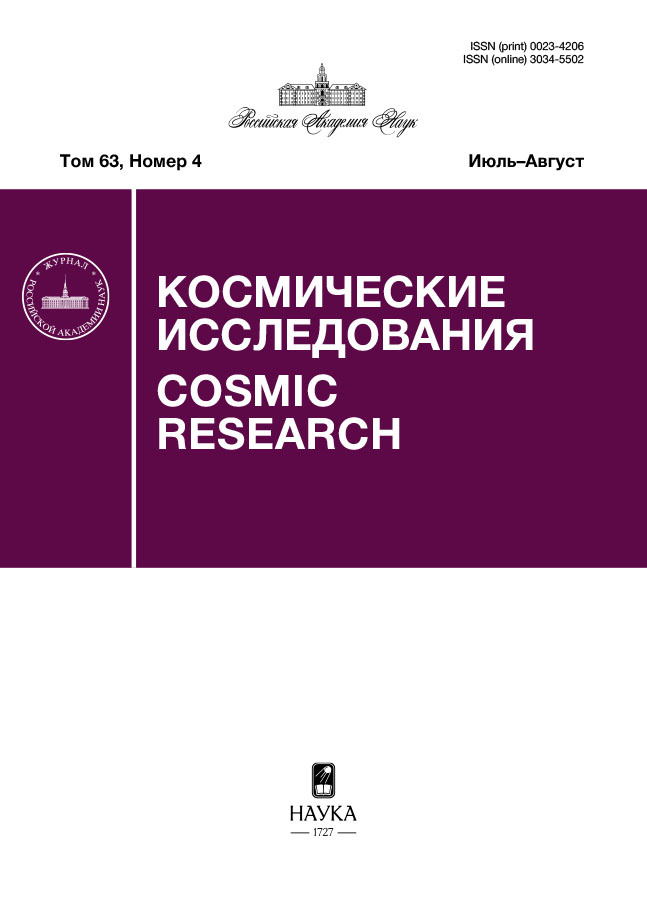Метод расчета траектории одноимпульсного перелета к гало-орбите вокруг точки либрации L2 системы Земля–Луна
- Авторы: Жуи Ч.1
-
Учреждения:
- Московский авиационный институт
- Выпуск: Том 61, № 5 (2023)
- Страницы: 382-392
- Раздел: Статьи
- URL: https://kazanmedjournal.ru/0023-4206/article/view/672609
- DOI: https://doi.org/10.31857/S0023420623700152
- EDN: https://elibrary.ru/PJVLGM
- ID: 672609
Цитировать
Полный текст
Аннотация
Рассматривается задача расчета низкоэнергетических импульсных траекторий к гало-орбитам в окрестности точки либрации L2 системы Земля–Луна. Представлен новый метод расчета траекторий одноимпульсного низкоэнергетического перелета к гало-орбите. Анализируется ограниченная задача четырех тел, в рамках которой учитывается притяжение Земли, Луны и Солнца, а их положение и скорость вычисляются с использованием высокоточного эфемеридного обеспечения. Особое внимание при разработке метода уделено обеспечению его вычислительной устойчивости для расчета траекторий с длительным нахождением космического аппарата в зоне слабой устойчивости вблизи границы сферы Хилла Земли. Приведены результаты расчета одноимпульсных траекторий перелета с низкой околоземной орбиты на гало-орбиты вокруг точки либрации L2 системы Земля–Луна. Проведен анализ зависимости основных характеристик одноимпульсных траекторий от даты подлета к гало-орбите.
Об авторах
Чжоу Жуи
Московский авиационный институт
Автор, ответственный за переписку.
Email: 420790076@qq.com
Россия, Москва
Список литературы
- Себехей В. Теория орбит: ограниченная задача трех тел / пер. с англ.; под ред. Г.Н. Дубошина. М.: Наука, 1982. 657 с.
- Маркеев А.П. Точки либрации в небесной механике и космодинамике. М.: Наука, 1978. 312 с.
- Folta D.C., Pavlak T.A., Haapala A.F. et al. Earth–Moon libration point orbit stationkeeping: Theory, modeling, and operations // Acta Astronaut. 2014. V. 94. Iss. 1. P. 421–433. https://doi.org/10.1016/j.actaastro.2013.01.022
- Shan G., Wenyan Z., Weiguang L. et al. Trajectory analysis and design for relay satellite at Lagrange L2 point of Earth-Moon system // J. Deep Space Exploration. 2017. V. 4. Iss. 2. P. 122–129.https://doi.org/10.15982/j.issn.2095-7777.2017.02.004
- Folta D.C., Pavlak T.A., Haapala A.F. et al. Earth–Moon libration point orbit stationkeeping: Theory, modeling, and operations // Acta Astronaut. 2014. V. 94. Iss. 1. P. 421–433. https://doi.org/10.1016/j.actaastro.2013.01.022
- Gordon D.P. Transfers to earth-moon L2 halo orbits: Master Thesis of Science in Aeronautics and Astronautics. Purdue University West Lafayette, Indiana, 2008. 182 p.
- Wu W., Tang Y., Zhang L., Qiao D. Design of communication relay mission for supporting lunar-farside soft landing // J. Science China Information Sciences. 2018. V. 61. Iss. 4. 14 p. https://doi.org/10.1007/s11432-017-9202-1
- Davis D., Bhatt S., Howell K. et al. Orbit maintenance and navigation of human spacecraft at cislunar near rectilinear halo orbits // 27th AAS/AIAA Space Flight Mechanics Meeting. 5–9 Feb. 2017, San Antonio, Texas. 2017. Art. ID. JSC-CN-38626. 21 p.
- Starchville T.F., Melton R.G. Optimal low-thrust trajectories to Earth–Moon L2 Halo orbits (circular problem). // Advances in the Astronautical Sciences. 1997. V. 97. P. 1741–1756.
- Parrish N.L., Parker J.S., Hughes S.P. et al. Low-thrust transfers from distant retrograde orbits to L2 halo orbits in the Earth-Moon system // 6th Intern. Conf. Astrodynamics Tools and Techniques. 14–17 March 2016, Darmstadt. 2016. Art. ID. GSFC-E-DAA-TN30224. 10 p.
- An R., Wang M., Liang X.G. Transfer trajectory optimal design for Earth-Moon L2 based on invariant manifolds // J. Deep Space Exploration. 2017. V. 4. Iss. 3. P. 252–257.
- Ivanyukhin A.V., Petukhov V.G. Low-Energy Sub-Optimal Low-Thrust Trajectories to Libration Points and Halo-Orbits // Cosmic Research. 2019. V. 57. Iss. 5. P. 378–388. https://doi.org/10.1134/S0010952519050022
- Lei H., Xu B., Sun Y. Earth–Moon low energy trajectory optimization in the real system // Advances in Space Research. 2013. V. 51. Iss. 5. P. 917–929. https://doi.org/10.1016/j.asr.2012.10.011
- Parker J.S., Born G.H. Modeling a low-energy ballistic lunar transfer using dynamical systems theory // J. Spacecraft and Rockets. 2008. V. 45. Iss. 6. P. 1269–1281. https://doi.org/10.2514/1.35262
- Qi Y., Xu S. Earth–Moon transfer with near-optimal lunar capture in the restricted four-body problem // Aerospace Science and Technology. 2016. V. 55. P. 282–291.
- Richardson D.L. Halo orbit formulation for the ISEE-3 mission // J. Guidance and Control. 1980. V. 3. Iss. 6. P. 543–548.
- Richardson D.L. Analytic construction of periodic orbits about the collinear points // Celestial mechanics. 1980. V. 22. Iss. 3. P. 241–253.
- Петухов В.Г., Чжоу Ж. Расчет возмущенной импульсной траектории перелета между околоземной и окололунной орбитами методом продолжения по параметру // Вестник Московского авиац. ин-та. 2019. Т. 26. Iss. 2. P. 155–165.
- Kokou P., Le Bihan B., Receveur J.B. et al. Computing an optimized trajectory between Earth and an EML2 halo orbit // Proc. 2014 IEEE Chinese Guidance, Navigation and Control Conf. (CGNCC). Yantai, China, 8–10 Aug. 2014. Art. ID. 0450.
- Belbruno E., Carrico J. Calculation of weak stability boundary ballistic lunar transfer trajectories // Astrodynamics Specialist Conf. 2000. Art. ID. AIAA 2000-4142. 11 p. https://doi.org/10.2514/6.2000-4142
- Petukhov V.G., Ivanyukhin A.V. Low-energy trajectories to the Earth–Moon libration points and to halo-orbits // IAA/AAS SciTech Forum 2019 on Space Flight Mechanics and Space Structures and Materials. Moscow. V. 174: Advances in the Astronautical Sciences Series. 2021. P. 81–94.
- Guzzetti D., Zimovan E.M., Howell K.C. et al. Stationkeeping analysis for spacecraft in lunar near rectilinear halo orbits // 27th AAS/AIAA Space Flight Mechanics Meeting. American Astronautical Society. 5–9 Feb. 2017, San Antonio, TX, USA. 2017. 20 p.
- Zimovan E.M., Howell K.C., Davis D.C. Near rectilinear halo orbits and their application in cis-lunar space // 3rd IAA Conf. Dynamics and Control of Space Systems. Moscow, Russia. 2017. P. 20–40.
- Whitley R.J., Davis D.C., Burke L.M. et al. Earth-Moon near rectilinear halo and butterfly orbits for lunar surface exploration // Proc. AAS/AIAA Astrodynamics Specialist Conf. 19–23 Aug. 2018, Snowbird, UT, USA.
- Zimovan-Spreen E.M., Howell K.C., Davis D.C. Near rectilinear halo orbits and nearby higher-period dynamical structures: orbital stability and resonance properties // Celestial Mechanics and Dynamical Astronomy. 2020. V. 132. Iss. 5. Art. ID. 28. 25 p. https://doi.org/10.1007/s10569-020-09968-2
- Smith M., Craig D., Herrmann N. et al. The Artemis program: an overview of NASA’s activities to return humans to the Moon // Proc. 2020 IEEE Aerospace Conf. Big Sky, MT, USA. 7–14 Mar. 2020. 10 p.
Дополнительные файлы




















